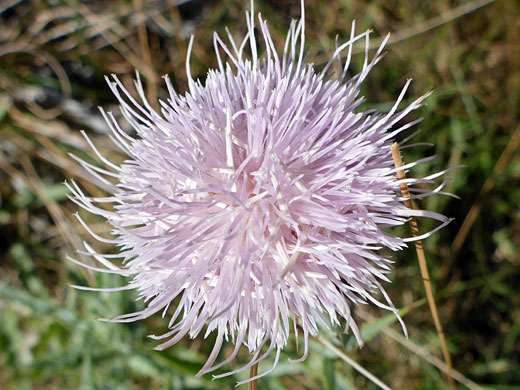Common name:
Mojave thistle
Family:
Scientific name:
Cirsium mohavense
Main flower color:
Range:
The Mojave Desert (AZ, CA, NV, UT), and some adjacent areas
Height:
Up to 8 feet
Habitat:
Springs, seeps, wet meadows, in deserts and wooded areas, from below sea level to 7,000 feet
Leaves:
Narrowly oblong to oblanceolate, spiny, unlobed to deeply pinnately lobed; up to 24 inches long and 5 inches wide
Season:
May to September
Cirsium mohavense produces one stem or several, branching a few times above the middle, and covered with dense, short, greyish-white tomentose hairs. Plants are tall, up to 8 feet, and leaves are correspondingly large, and variable in appearance; they may be simple and lightly spined, or shallowly to deeply pinnately lobed, the lobes linear to triangular or ovate, toothed or entire. The longest spines are over one inch. Both leaf surfaces are also usually tomentose hairy (especially underneath). Leaves grow at the base (not withered at flowering) and all along the stem; the uppermost are simple, well-separated and much reduced in size.
Heads may be single, or (more usually) part of small, open arrays, and are attached by leafy stalks up to 4 inches long. The egg-shaped or hemispherical involucres are ringed by between five and eight rows of green to brownish phyllaries, topped by brown, spreading spines. Below the spine is a narrow ridge, usually whitish. Phyllary margins are loosely tomentose, becoming glabrous when mature. Florets are colored white to lavender or pale pink, and are around one inch long.
Heads may be single, or (more usually) part of small, open arrays, and are attached by leafy stalks up to 4 inches long. The egg-shaped or hemispherical involucres are ringed by between five and eight rows of green to brownish phyllaries, topped by brown, spreading spines. Below the spine is a narrow ridge, usually whitish. Phyllary margins are loosely tomentose, becoming glabrous when mature. Florets are colored white to lavender or pale pink, and are around one inch long.
All Contents © Copyright The American Southwest | Comments and Questions | Contribute | Site Map



